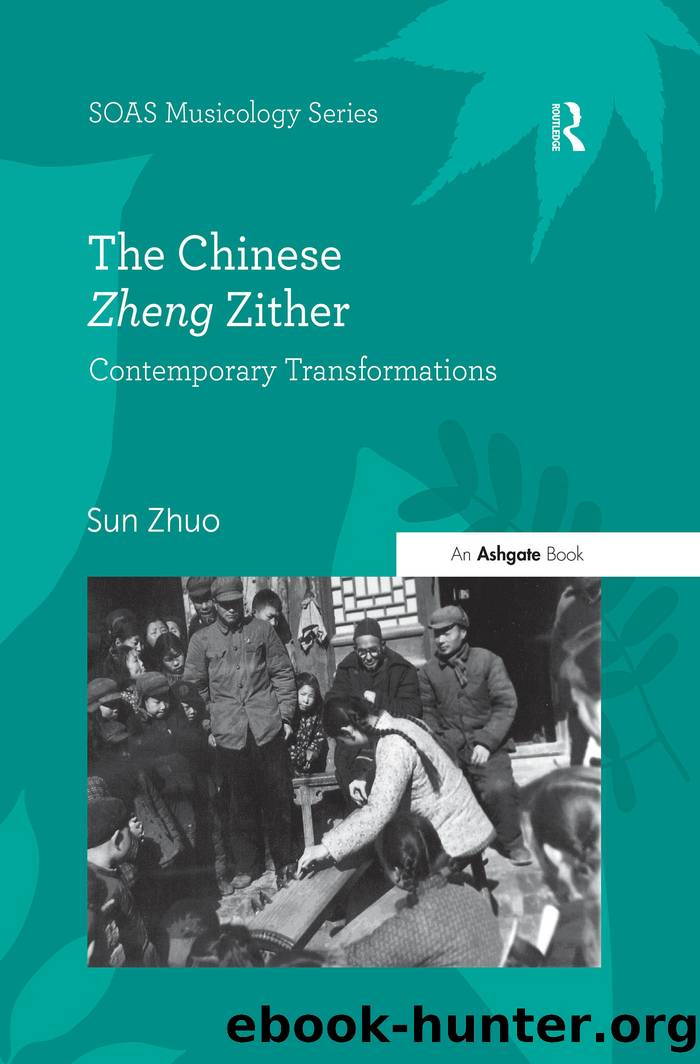The Chinese Zheng Zither by Sun Zhuo

Author:Sun Zhuo
Language: eng
Format: epub
Publisher: Taylor and Francis
Published: 2015-01-15T00:00:00+00:00
Chapter 5
Contemporary Zheng Music and Practice in an International Setting Background: New Music and the Zheng
New Music in China
Since the opening up of China in the 1980s, the trend in Chinese music composition for taking up developments in late twentieth-century music from outside the country has been paralleled by a general resurgence of interest in traditional Chinese music. In contrast with previous decades, during which the majority of zheng music was composed by zheng players, since the 1980s conservatory-based or trained professional composers have joined in the composition of zheng music. Together with zheng players, they have brought a series of innovative changes into zheng music and endowed it with a new outlook.
Such new music for zheng has drawn great inspiration from a wider range of musical materials, such as Han folk music, minority folk music, indigenous music from outside of China, Western art music and new compositional techniques. For example, both modern Japanese koto compositions and philosophies and ideas explored by the avant-garde movement in Western Art Music have played an important and influential role. Compared to earlier zheng pieces, which were created by folk musicians, literati musicians and zheng players, new zheng compositions written by a newer generation of composers, including non-performers, often show a variety of traits such as formal musical structures borrowed from the Western classical tradition, newly developed complex playing techniques, and flexible tunings. Together, these aspects have formed a style of modern professional practice for conservatory-style zheng performance. At the same time, this style has also come to be well accepted by expanding urban zheng music audiences.
In the popular music sphere, following the reform period which began in the late 1970s, compelling Western and gangtai (Hong Kong and Taiwan) pop movements were (and remain) dominant. By the 1980s, widespread recognition of a need to reassert native Chinese culture gradually gathered steam and finally came into its own, firstly in pop music, where a new genre called xibei feng (northwest wind) came into being (Baranovitch 2003: 18â26): âThis [xibei feng] is a strongly affective response, stated in terms of evoking feelings of national identity and a deserved international membershipâ (Brace 1991: 51).
Along with the xibei feng music movement, a general upsurge of interest in traditional Chinese culture emerged simultaneously in urban societies. Chinese instrumentalists also rose to this opportunity, and greatly extended and developed its range. A huge market for traditional Chinese instrumental music soon developed in Chinaâs cities.
Since the 1980s, a boom in after-school classes has provided the impulse for a more broad-based development of the instrumentâs repertoire and teaching methodologies. The majority of pupils are children and school students, joined by some adult learners. Unlike the zheng in the old folk context, which was dominated by male players, in this new peak, the zheng has somehow been endowed with a feminine image; among the newly developed and huge zheng-playing population, the overwhelming majority are girls.1
By the year 2000, the number of students participating in after-school zheng classes totalled over a million (Wang Shihuang 1985: 41; Wang Zhongshan2006: 34).
Download
This site does not store any files on its server. We only index and link to content provided by other sites. Please contact the content providers to delete copyright contents if any and email us, we'll remove relevant links or contents immediately.
The Goal (Off-Campus #4) by Elle Kennedy(12450)
Kathy Andrews Collection by Kathy Andrews(10559)
Diary of a Player by Brad Paisley(6872)
What Does This Button Do? by Bruce Dickinson(5537)
Assassin’s Fate by Robin Hobb(5255)
Big Little Lies by Liane Moriarty(4892)
Pale Blue Dot by Carl Sagan(4018)
Sticky Fingers by Joe Hagan(3459)
The Heroin Diaries by Nikki Sixx(2942)
The Death of the Heart by Elizabeth Bowen(2910)
Beneath These Shadows by Meghan March(2730)
The Help by Kathryn Stockett(2708)
Confessions of a Video Vixen by Karrine Steffans(2682)
How Music Works by David Byrne(2539)
Jam by Jam (epub)(2496)
Harry Potter 4 - Harry Potter and The Goblet of Fire by J.K.Rowling(2422)
Strange Fascination: David Bowie: The Definitive Story by David Buckley(2371)
Petty: The Biography by Warren Zanes(2241)
Darker Than the Deepest Sea by Trevor Dann(2214)
